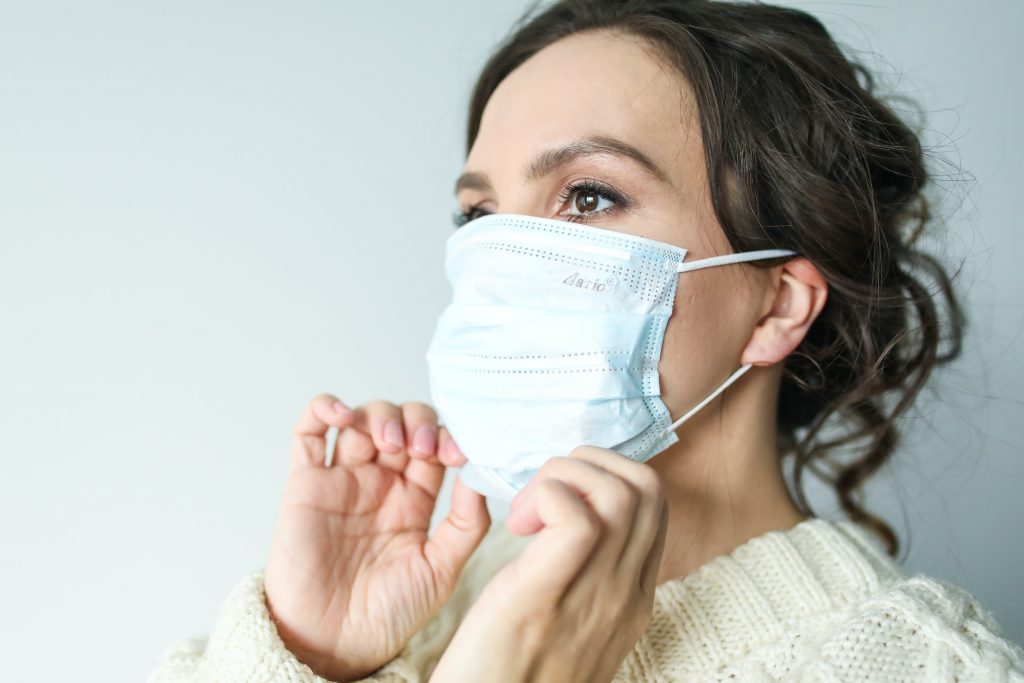Face coverings and masks are part of our lives now and, for a lucky few, so is “maskne.”
Maskne refers to the zits and blemishes showing up around our mouths, chins and jawlines as a result of covering our faces. It’s just another example of how breakouts and the coronavirus have gone hand-in-hand the past few months as stress and lack of routine tend to come out on our skin.
Melanie Palm, a board-certified dermatologist and cosmetic surgeon based out of San Diego, California, said skin issues such as acne, seborrheic dermatitis and perioral dermatitis are becoming huge issues among her patients. Face coverings and masks can wreak havoc on our face since they change its micro-environment. The skin’s microbiome (aka the balance of good and bad bacteria on your skin), oil and sweat production, and skin turnover are all being affected.
“The combination of mask coverings and makeup can also produce challenging skin issues,” she said.
Masks help protect others and ourselves, but maskne isn’t welcome. Here are some products and ingredients that help prevent and treat breakouts as well as tips and tricks to banish mask-induced blemishes from your life.
Cleansing
Any good routine starts with cleansing in order to remove makeup and cellular buildup and sweep off excess sebum, aka oil, Palm said.
I would suggest a double cleanse, especially if you wear makeup. The idea is rooted in the fact that like attracts like. Go in with an oil-based cleanser first to remove the oil, SPF, makeup and more on your skin. Then, use a typical cleanser to clean your skin. Stay away from any with mineral oil, paraffin or paraffin liquid since those can clog pores. Instead, look for plant-derived oils in the ingredients; I love Farmacy Green Clean Makeup Meltaway Cleansing Balm.
For a second cleanse, stay away from anything with alcohol among the first five ingredients because they can dry out your skin and make it worse by destroying the acid mantle. I like WLDKAT PH-Balanced Patchouli + Cherimoya Gel Cleanser.
Also, implementing a cleansing tool will help get into the acne-prone nooks and crannies, such as the corner of the nose or chin, Palm said. I love my Clarisonic Mia 2, but it’s unfortunately been discontinued. You can try Mia Prima Acne Solution Set or you also can find a generic cleansing brush that can do the job.
Moisturizing
Palm recommends using a lightweight, fragrance-free moisturizer with ingredients such as glycerin and niacinamide, which both help strengthen the skin barrier. CeraVe Moisturizing Lotion and pretty much anything by La Roche-Posay are nice, fragrance-free and gentle. Drunk Elephant Protini Polypeptide Cream is my personal favorite, but it’s pricey ($68 — yikes). The Inkey List Peptide Moisturizer is a pretty close dupe (and just $14.99).
Wait least 15 minutes after application to make sure your skin can fully absorb it before putting on a mask, Palm said.
Treatments
Using salicylic acid, or beta hyhdroxy acid (BHA), works excellently to combat maskne, Palm said.
“BHAs effectively penetrate down the hair follicle where acne starts,” she said. “It is able to break the adhesions between dead skin cells, lifting dull, flaky skin off to reveal the glowing, healthy skin below.”
BHA can come in different forms, including serums, liquids (like toners), creams or even cleansers. I prefer my BHA in liquid form, applied after cleansing one to three times per week, depending on skin sensitivity. Paula’s Choice Skin Perfecting 2% BHA Liquid is a nice option. So are Glossier Solution or my personal favorite, Tarte Knockout Tingling Treatment, both of which contain BHA as well as AHAs and PHAs (alpha and poly hydroxy acids) to help exfoliate and penetrate the pores. These are a little more potent, too, each with a 10% acid blend.
You also can use a cleanser with BHA, including CeraVe SA Renewing Cleanser or something from La Roche-Posay’s Effaclar line. However, I would pick one BHA product in your daily routine and not double-dip because that can cause over-exfoliation and irritation.
Masks
Palm recommended using an exfoliating mask at night once a week.
If your skin is more oily, you can use a clay-based mask, such as SkinCeuticals Clarifying Clay Masque, which contains AHAs such as malic, lactic, tartaric, citric and glycolic acids to resurface skin, and kaolin clay to help clarify skin and absorb excess oil. For normal or dry skin, try Bliss Pumpkin Powerhouse Resurfacing & Exfoliating Enzyme Mask, which is made with pumpkin enzymes to gently break up bonds between dead skin cells, and AHAs loosen and dissolve them.
Mask after cleansing and before your skin care routine. Take it easy on masking nights. I wouldn’t use acids, and I would use a super hydrating night cream to support your skin’s moisture barrier, such as Korres Greek Yoghurt Sleeping Facial or ITCosmetics Confidence in Your Beauty Sleep Night Cream.
Inside and out
Palm said to make sure you frequently clean beauty tools such as brushes and sponges to decrease the opportunity for breakouts or, worse, skin infections. Change your pillowcase at least once a week (more than that if you are more oily), and make sure your masks are clean.
As far as prevention from the inside, taking oral probiotics has been shown to improve skin concerns, including breakouts. Look for ones with Lactobacillus acidophilus and Lactobacillus bulgaricus. I also take fish oil supplements, which contain omega fatty acids for inside-out hydration, and I know it’s boring, but drink water.
Also, listen to your body. If something seems very severe or stubborn, get in touch with a professional right away.

Gia Mazur is an award-winning staff writer and beauty obsessive who joined The Times-Tribune’s Lifestyles department in 2015. She’s a product enthusiast who can’t live without an eyelash curler. A proud Virgo, Charlotte Tilbury Matte Revolution Lipstick in Pillow Talk is her go-to. Contact: gmazur@timesshamrock.com; 570-348-9127; @gmazurTT




